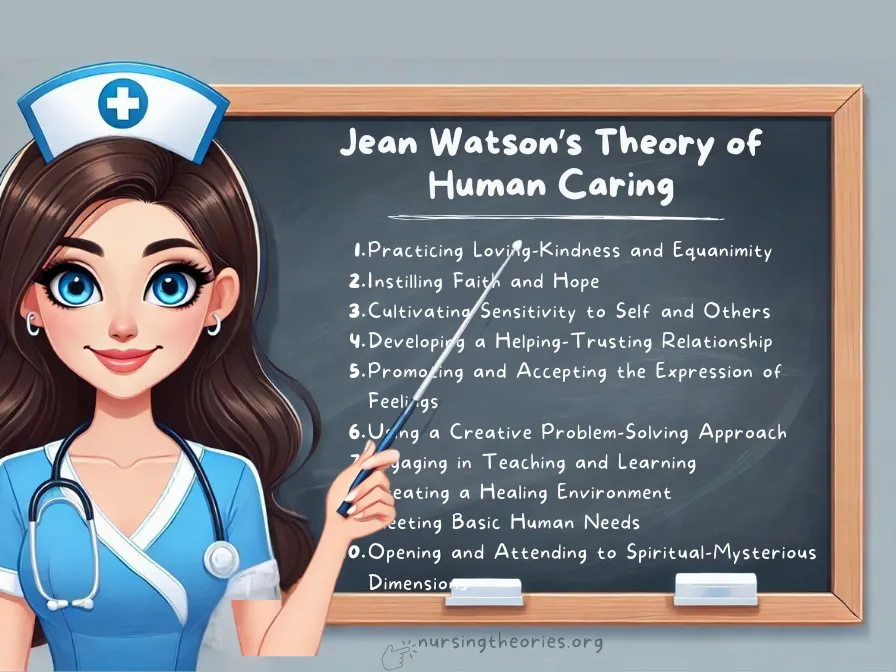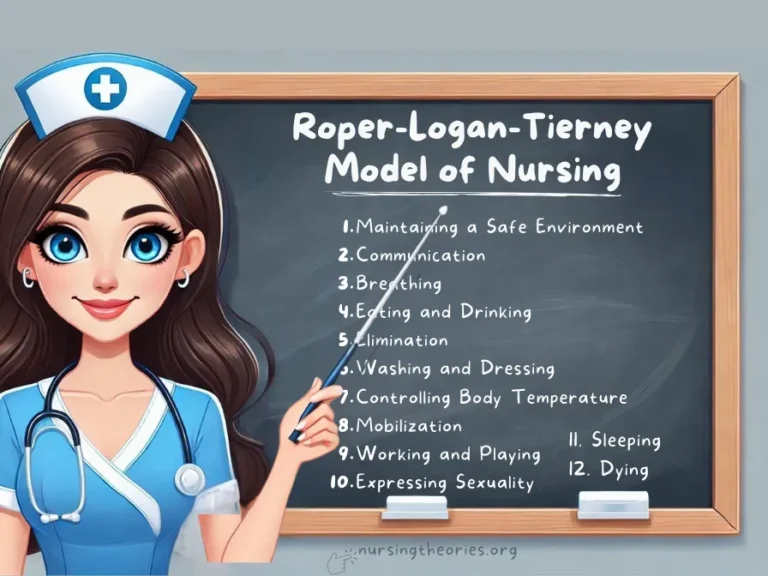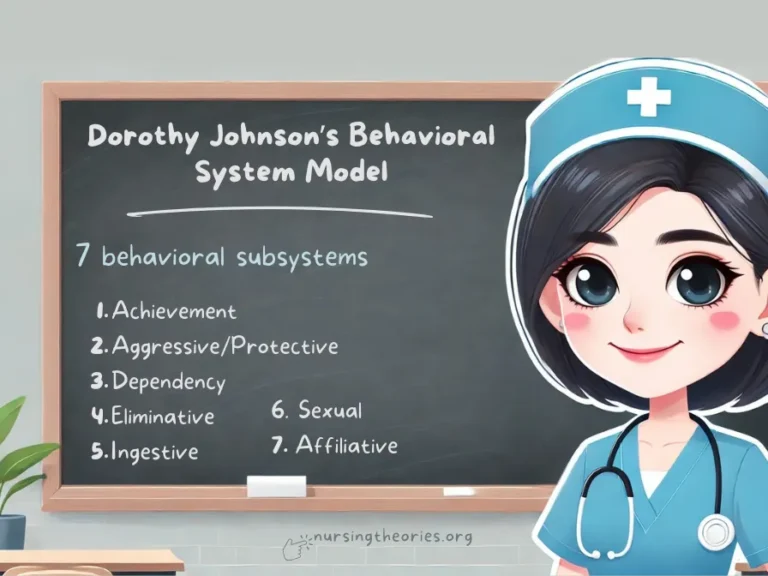Jean Watson, an American nurse theorist, is widely known for her transformative work in nursing.
Her Theory of Human Caring revolutionized how nurses approach patient care by emphasizing the importance of compassion, empathy, and human connection.
Watson’s theory focuses on treating patients holistically by addressing their physical, emotional, social, and spiritual needs—rather than focusing solely on their medical conditions.
The 10 Carative Factors, which have since evolved into the Caritas Processes, are at the heart of Watson’s framework.
These elements highlight the significance of a healing environment, transpersonal relationships, and emotional support in promoting patient well-being.
This article will guide you through the theory’s core concepts, practical applications, and real-life case studies, illustrating how Watson’s work can be integrated into modern nursing to foster holistic healing and positive outcomes.

What You’ve Learned – Jean Watson’s Theory of Human Caring
- Holistic patient care is essential: Watson’s theory emphasizes treating the whole person, including their physical, emotional, and spiritual needs.
- The 10 Carative Factors guide compassionate care: These factors form the foundation for providing empathy, dignity, and human connection in nursing.
- Transpersonal relationships foster healing: By forming deep, meaningful connections with patients, nurses can support emotional recovery alongside physical healing.
- A healing environment is critical to recovery: Creating a safe, calming space that promotes comfort and trust accelerates patient outcomes.
- Modern nursing can incorporate Watson’s principles: Despite fast-paced healthcare settings, integrating holistic and compassionate care improves long-term recovery and patient satisfaction.
Core Concepts of Jean Watson’s Theory of Human Caring
The 10 Carative Factors in Jean Watson’s Theory
At the core of Watson’s theory are the 10 Carative Factors, which guide nurses in providing holistic, compassionate care.
These factors have since evolved into the Caritas Processes, reflecting a more spiritual and ethical emphasis on healing.
Here’s a breakdown of the 10 Carative Factors of Watson’s nursing theory:
- Practicing Loving-Kindness and Equanimity
Nurses are encouraged to bring love, kindness, and calmness to every interaction, fostering trust and a healing relationship. - Instilling Faith and Hope
By nurturing a positive outlook, nurses inspire patients to remain hopeful and motivated throughout their recovery, even in difficult situations. - Cultivating Sensitivity to Self and Others
Developing empathy and emotional awareness allows nurses to be fully present with patients, creating meaningful and healing connections. - Developing a Helping-Trusting Relationship
Building trust through open communication and genuine concern strengthens the nurse-patient bond, providing emotional comfort and security. - Promoting and Accepting the Expression of Feelings
Creating a safe space for patients to express their emotions—whether joy, fear, or sadness—helps relieve stress and supports emotional healing. - Using a Creative Problem-Solving Approach
Nurses are encouraged to think critically and creatively, applying individualized care plans that address patients’ unique needs holistically. - Engaging in Teaching and Learning
Sharing knowledge with patients empowers them to participate in their care, fostering a sense of autonomy and understanding of their health. - Creating a Healing Environment
The nurse focuses on maintaining both a physically soothing and emotionally supportive environment that promotes healing on multiple levels. - Meeting Basic Human Needs
Nurses prioritize addressing not only physical needs like pain management and nutrition but also emotional and spiritual well-being. - Opening and Attending to Spiritual-Mysterious Dimensions
Recognizing the spiritual aspect of healing, nurses honor the patient’s beliefs, values, and search for meaning during their health journey.
Key Insight:
Watson’s Carative Factors differ from conventional clinical practices by focusing on the emotional and human aspects of care, ensuring that patients feel valued, safe, and respected.
Think of it as…
A toolkit that helps nurses not only treat the body but also nurture the mind and soul, creating a comprehensive healing process.
Holistic Healing and Compassion in Jean Watson’s Human Caring Model
Watson’s theory integrates all aspects of a patient’s well-being—physical, emotional, social, and spiritual.
Holistic healing goes beyond treating symptoms; it requires nurses to recognize the human experience of illness and provide care that addresses psychological needs, such as fear, anxiety, and isolation.
For example, a nurse caring for a terminally ill patient might focus on both managing pain and offering emotional support through active listening and mindfulness practices.
Key Insight:
Holistic care leads to improved patient satisfaction and long-term health outcomes, as it acknowledges the patient as a complex individual, not just a medical case.
Think of it as…
A garden where you nurture not just the plant’s growth but also the soil, sunlight, and environment that allow it to thrive.
Transpersonal Caring Relationship in Watson’s Human Caring Theory
One of the key features of Watson’s theory is the transpersonal caring relationship, which involves a deep, meaningful connection between the nurse and the patient.
This connection is rooted in mutual respect, trust, and empathy, allowing the nurse to enter the patient’s “life space” and understand their unique experiences of health and illness.
In practice, this might involve a nurse spending time with a patient beyond performing clinical tasks, listening to their concerns, and offering emotional comfort.
Key Insight:
Transpersonal caring relationships create a sense of trust and security, which can improve emotional healing and enhance the effectiveness of medical treatments.
Think of it as…
Building a bridge between the nurse and the patient, where understanding and compassion travel freely to promote holistic healing.
Practical Applications of Jean Watson’s Theory of Human Caring
Fostering a Healing Environment with Watson’s Human Caring Theory
The environment in which patients receive care significantly affects their healing process.
Watson’s theory emphasizes creating an environment that promotes emotional and physical well-being, which can include simple changes like maintaining a clean and calming room, playing soothing music, or allowing natural light to flow in.
Example: A post-surgical patient in a hospital may experience anxiety and stress due to unfamiliar surroundings.
A nurse applying Watson’s principles could introduce relaxation techniques, dim the lights, and ensure a clutter-free, peaceful room to enhance recovery.
Key Insight: The healing environment is not just physical—it also encompasses the emotional climate created by the nurse’s compassion and presence.
Think of it as… Setting the stage for healing, where comfort and calmness become active participants in the recovery process.
Meeting Emotional and Spiritual Needs Through Jean Watson’s Human Caring Practices
Emotional and spiritual needs are often neglected in clinical settings, but Watson’s theory highlights their importance in the healing journey.
Nurses can help patients express their fears, anxieties, and hopes while offering emotional support through active listening and empathy.
Example: A cancer patient undergoing chemotherapy may feel overwhelmed by their diagnosis.
The nurse can offer emotional reassurance and spiritual support, such as facilitating a visit from a religious counselor or incorporating relaxation exercises into the daily care plan.
Key Insight: Meeting emotional needs allows patients to feel heard and supported, which can reduce stress and improve overall well-being.
Think of it as… Watering the roots of a plant—emotional support nourishes the underlying foundation of healing.
Promoting Patient Dignity and Autonomy Using Watson’s Carative Factors
Patient dignity and autonomy are central to Watson’s humanistic approach.
Nurses should empower patients to be active participants in their care decisions while maintaining their sense of self-worth and respect.
Example: For a patient with limited mobility, involving them in creating their care plan—such as choosing their daily schedule or having input on treatment options—ensures that their preferences are respected.
Key Insight: When patients feel dignified and in control, they are more likely to engage in the healing process and experience better outcomes.
Think of it as… Handing someone the steering wheel to their own recovery journey, allowing them to feel confident in their ability to heal.
Applying the Nursing Process through Jean Watson’s Human Caring Theory
Step 1: Holistic Assessment Guided by Jean Watson’s Human Caring Model
Nurses begin by conducting a comprehensive assessment of the patient’s physical, emotional, and spiritual needs.
Using Watson’s carative factors as a guide, the assessment goes beyond clinical symptoms to uncover underlying fears, concerns, and environmental stressors.
Example: When assessing a patient with chronic pain, the nurse also evaluates their mental health, support system, and spiritual outlook to gain a complete understanding of their condition.
Key Insight: A thorough assessment ensures that no aspect of the patient’s well-being is overlooked.
Think of it as… Peeling back the layers of an onion to discover the core issues affecting the patient’s health.
Step 2: Creating a Personalized Caring Plan Based on Watson’s Caritas Processes
A personalized care plan is designed to address the unique needs of the patient, incorporating medical interventions alongside emotional and spiritual support.
Example: For a patient recovering from a traumatic injury, the care plan might include physical therapy sessions, counseling, and relaxation techniques to reduce stress.
Key Insight: Personalized care plans acknowledge that each patient’s healing journey is unique.
Think of it as… Tailoring a suit to fit perfectly—care plans should be customized to suit individual patient needs.
Step 3: Implementing Caring Interventions from Watson’s Theory of Human Caring
Nurses implement interventions based on the carative factors, such as providing emotional support, involving family members, and maintaining a healing environment.
Example: A nurse might encourage family members to participate in a patient’s care to provide emotional comfort and support.
Key Insight: Integrating emotional care with physical interventions ensures comprehensive patient care.
Think of it as… Building a sturdy bridge where clinical expertise and compassionate care meet.
Step 4: Creating a Healing Environment for Patient Recovery
Healing environments are designed to be peaceful, supportive, and free from unnecessary stressors.
They can include calming sounds, personalized care spaces, and emotional reassurance from the care team.
Key Insight: The environment itself becomes a therapeutic tool that enhances the effectiveness of nursing interventions.
Think of it as… Turning the care setting into a sanctuary that nurtures recovery.
Step 5: Evaluating Outcomes Using Watson’s Human Caring Framework
Nurses regularly evaluate the effectiveness of their interventions and adjust care plans as needed based on the patient’s progress.
Key Insight: Continuous evaluation allows for dynamic, flexible care that meets the patient’s changing needs.
Think of it as… Checking a GPS during a journey to ensure you’re on the right path and making course corrections when needed.
Real-Life Case Studies Using Jean Watson’s Theory of Human Caring
Case Study 1: Transpersonal Comfort Care for a Terminally Ill Patient
A nurse caring for a terminally ill patient with advanced cancer used Watson’s theory to create a supportive environment that addressed the patient’s fear of dying.
The nurse provided emotional support, arranged spiritual visits, and spent time listening to the patient’s concerns, which improved the patient’s emotional well-being and acceptance of their condition.
Case Study 2: Emotional and Psychological Support for a Postpartum Patient
A mother experiencing postpartum depression received care guided by Watson’s carative factors.
The nurse provided active listening sessions, helped the mother create a self-care plan, and involved family members in her recovery process.
These interventions improved the patient’s emotional stability and allowed her to bond more effectively with her newborn.
Case Study 3: Enhanced Recovery Using a Healing Environment Post-Surgery
A post-surgical patient recovering from heart surgery experienced significant anxiety about their prognosis.
By applying Watson’s principles, the nurse created a calming environment, offered daily emotional check-ins, and encouraged mindfulness practices.
As a result, the patient reported decreased anxiety and faster recovery.
Modern Implications of Jean Watson’s Human Caring Theory
Why Watson’s Theory of Human Caring Is Essential for Modern Nursing
As healthcare becomes more fast-paced and technologically driven, Watson’s theory serves as a reminder of the importance of compassionate, patient-centered care.
Its emphasis on empathy, human connection, and holistic healing addresses the depersonalization often found in modern clinical settings.
Role of Jean Watson’s Human Caring Model in Long-Term and Palliative Care
Watson’s theory is especially relevant in chronic care and end-of-life settings, where emotional and spiritual needs play a critical role in patient well-being.
Providing holistic support improves both quality of life and patient satisfaction.
Integration of Watson’s Theory into Modern Hospital Systems
Many hospitals and healthcare systems have integrated Watson’s carative principles into their clinical protocols, focusing on creating healing environments, fostering empathy, and training nurses in holistic practices.
Challenges and Limitations of Jean Watson’s Theory of Human Caring
Balancing Emotional Care and Clinical Efficiency
One challenge is providing holistic care in time-pressured environments, where nurses may struggle to balance emotional support with clinical duties.
Measuring the Subjective Aspects of Transpersonal Caring
Because emotional and spiritual outcomes are difficult to measure objectively, evaluating the success of Watson’s theory can be challenging.
Implementing Consistent Caring Practices Across Diverse Settings
Different hospital environments and patient populations may require customized approaches to apply Watson’s theory effectively.
Jean Watson’s Theory of Human Caring Quiz
1) What is the primary focus of Jean Watson’s Theory of Human Caring?
a) Administering medications efficiently
b) Reducing hospital stay duration
c) Holistic healing and transpersonal relationships
d) Meeting physical needs only
2) Which of the following is one of Watson’s Carative Factors?
a) Early diagnosis
b) Environmental sanitation
c) Promoting hope and faith
d) Medication adherence
3) What does a transpersonal caring relationship involve?
a) A surface-level conversation with patients
b) Emotional disconnection to avoid stress
c) Deep emotional connections to support healing
d) Only following clinical guidelines
4) What is a key way to foster a healing environment according to Watson?
a) Provide medications on time
b) Ensure a quiet, peaceful space
c) Limit family involvement
d) Focus on the clinical procedure only
5) How does Watson’s theory view patient autonomy?
a) As unimportant in nursing care
b) As secondary to medical decisions
c) As a central aspect of promoting dignity
d) As only applicable in palliative care
Jean Watson’s Theory of Human Caring Quiz Answers with Rationale
- Correct Answer: c) Holistic healing and transpersonal relationships
Rationale: Watson’s theory focuses on holistic healing by addressing physical, emotional, and spiritual dimensions. - Correct Answer: c) Promoting hope and faith
Rationale: Instilling faith and hope is one of the 10 Carative Factors, which support emotional and spiritual healing. - Correct Answer: c) Deep emotional connections to support healing
Rationale: Transpersonal caring relationships involve connecting with patients on a deeper level to foster trust and promote healing. - Correct Answer: b) Ensure a quiet, peaceful space
Rationale: A healing environment minimizes stress and creates a sense of calm, which is essential for recovery. - Correct Answer: c) As a central aspect of promoting dignity
Rationale: Watson’s theory emphasizes patient autonomy and dignity, making them key to holistic care.
Questions and Answers on Jean Watson’s Theory of Human Caring
Q1: What is the goal of the Carative Factors?
A: To guide nurses in providing holistic, compassionate care that addresses emotional, spiritual, and physical needs.
Q2: How does Watson’s theory differ from conventional clinical approaches?
A: It focuses on treating the whole person, not just the illness, through transpersonal caring and holistic practices.
Q3: Why is the transpersonal relationship important?
A: It fosters trust and emotional connection, which enhances the healing process and improves outcomes.
Q4: How does Watson’s theory apply in end-of-life care?
A: It provides emotional and spiritual support, promoting dignity and comfort for terminally ill patients.
Q5: What is a practical example of creating a healing environment?
A: Ensuring quiet surroundings, playing calming music, and incorporating soothing visual elements in the patient’s room.
Conclusion of Jean Watson’s Theory of Human Caring
Jean Watson’s Theory of Human Caring highlights the importance of compassion, empathy, and human connection in nursing.
By focusing on holistic healing and addressing patients’ emotional and spiritual needs, nurses can provide care that goes beyond treating symptoms.
As healthcare continues to evolve, Watson’s model remains a crucial reminder that at the core of nursing lies the patient’s humanity and dignity.
Final Reflective Question: How can you adapt Watson’s carative principles to fit the demands of your specific nursing practice or clinical setting?




